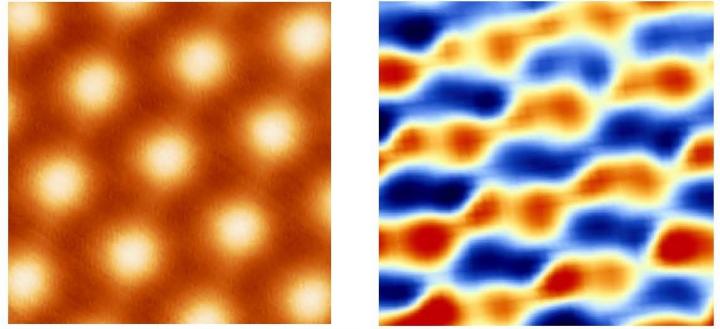Physicists make graphene discovery that could help develop superconductors

Left: This image, taken with a scanning tunneling microscope, shows a moiré pattern in "magic angle" twisted bilayer graphene. Right: Scanning tunneling charge spectroscopy, a technique invented by Professor Eva Andrei's group, reveals correlated electrons as shown by the alternating positive (blue) and negative (red) charge stripes that formed in the "magic angle" twisted bilayer graphene seen in the image at left. Credit: Yuhang Jiang/Rutgers University-New Brunswick
When two mesh screens are overlaid, beautiful patterns appear when one screen is offset. These “moiré patterns” have long intrigued artists, scientists and mathematicians and have found applications in printing, fashion and banknotes.
Now, a Rutgers-led team has paved the way to solving one of the most enduring mysteries in materials physics by discovering that in the presence of a moiré pattern in graphene, electrons organize themselves into stripes, like soldiers in formation.
Their findings, published in the journal Nature, could help in the search for quantum materials, such as superconductors, that would work at room temperature. Such materials would dramatically reduce energy consumption by making power transmission and electronic devices more efficient.
“Our findings provide an essential clue to the mystery connecting a form of graphene, called twisted bilayer graphene, to superconductors that could work at room temperature,” said senior author Eva Y. Andrei, Board of Governors professor in Rutgers' Department of Physics and Astronomy in the School of Arts and Sciences at Rutgers University-New Brunswick.
Graphene – an atomically thin layer of the graphite used in pencils – is a mesh made of carbon atoms that looks like a honeycomb. It's a great conductor of electricity and much stronger than steel.
The Rutgers-led team studied twisted bilayer graphene, created by superimposing two layers of graphene and slightly misaligning them. This creates a “twist angle” that results in a moiré pattern which changes rapidly when the twist angle changes.
In 2010, Andrei's team discovered that in addition to being pretty, moiré patterns formed with twisted bilayer graphene have a dramatic effect on the electronic properties of the material. This is because the moiré pattern slows down the electrons that conduct electricity in graphene and zip past each other at great speeds.
At a twist angle of about 1.1 degrees – the so-called magic angle – these electrons come to an almost dead stop. The sluggish electrons start seeing each other and interact with their neighbors to move in lock-step. As a result, the material acquires amazing properties such as superconductivity or magnetism.
Using a technique invented by Andrei's group to study twisted bilayer graphene, the team discovered a state where the electrons organize themselves into stripes that are robust and difficult to break.
“Our team found a close resemblance between this feature and similar observations in high-temperature superconductors, providing new evidence of the deep link underlying these systems and opening the way to unraveling their enduring mystery,” Andrei said.
###
The lead author is Rutgers post-doc Yuhang Jiang. Rutgers co-authors include post-doc Jinhai Mao, graduate student Xinyuan Lai and Professor Kristjan Haule. Scientists at the National Institute for Materials Science in Japan contributed to the study.
Media Contact
All latest news from the category: Materials Sciences
Materials management deals with the research, development, manufacturing and processing of raw and industrial materials. Key aspects here are biological and medical issues, which play an increasingly important role in this field.
innovations-report offers in-depth articles related to the development and application of materials and the structure and properties of new materials.
Newest articles

Silicon Carbide Innovation Alliance to drive industrial-scale semiconductor work
Known for its ability to withstand extreme environments and high voltages, silicon carbide (SiC) is a semiconducting material made up of silicon and carbon atoms arranged into crystals that is…

New SPECT/CT technique shows impressive biomarker identification
…offers increased access for prostate cancer patients. A novel SPECT/CT acquisition method can accurately detect radiopharmaceutical biodistribution in a convenient manner for prostate cancer patients, opening the door for more…

How 3D printers can give robots a soft touch
Soft skin coverings and touch sensors have emerged as a promising feature for robots that are both safer and more intuitive for human interaction, but they are expensive and difficult…





















